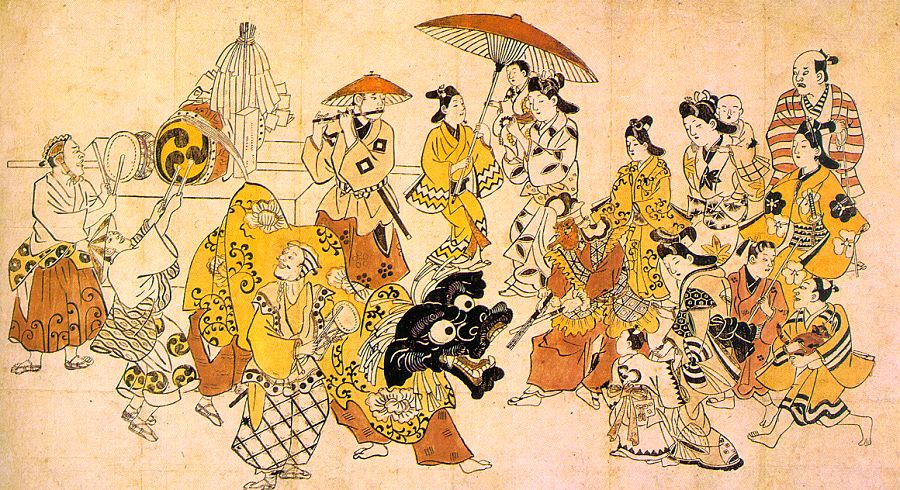
Lively festivals, bright costumes, glamorous women and eager crowds–welcome to the floating world of the Yoshiwara! This is Edo’s pleasure district, the Las Vegas and Montmartre of 18th century Japan. If you were a visitor to such an event, what better souvenir than a woodblock print by a popular Japanese artist?
The shishi-mai or Lion Dance, pictured above, is often performed at New Year’s celebrations. Dancers and musicians on the left entertain the crowd, wearing their holiday best, on the right. One woman carries an infant on her back, while a mother comforts her frightened child in the foreground. At centre, an aristocrat watches under the shade of an umbrella.
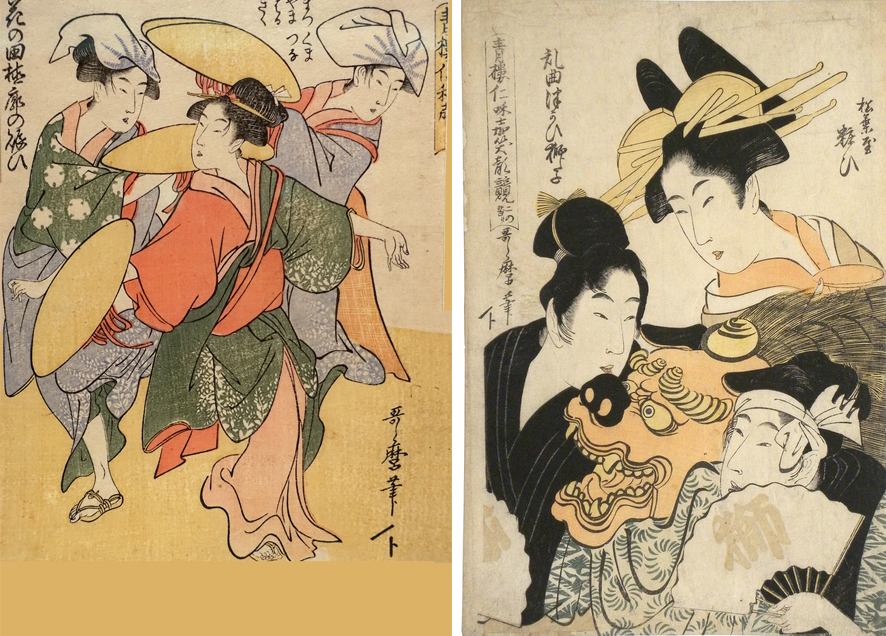
Utamaro takes a different approach to the same dance, right above, as a sake-drinking courtesan gets a close view of the performers. These images record events from the Niwaka Festival in Edo. Niwaka translates as ‘spontaneous’ because of its origins as impromptu street performances by courtesans and geishas looking to boost business. Over time, the Festival, held on the 8th lunar month, became a regular event including processions, floats, skits and dances. Performers of both sexes wore elaborate costumes (frequently cross-gender) and carried painted fans to signal the subject of their play. During the festival, access to the pleasure quarters was open to all, giving women and families a rare opportunity to enjoy the spectacle of the Yoshiwara. (Info from Kiyoshi Shibui, Ukiyo-e Zuten: Utamaro, 1964 and Gina Collia-Suzuki, The Complete Woodblock Prints of Kitagawa Utamaro, A Descriptive Catalogue, 2009)
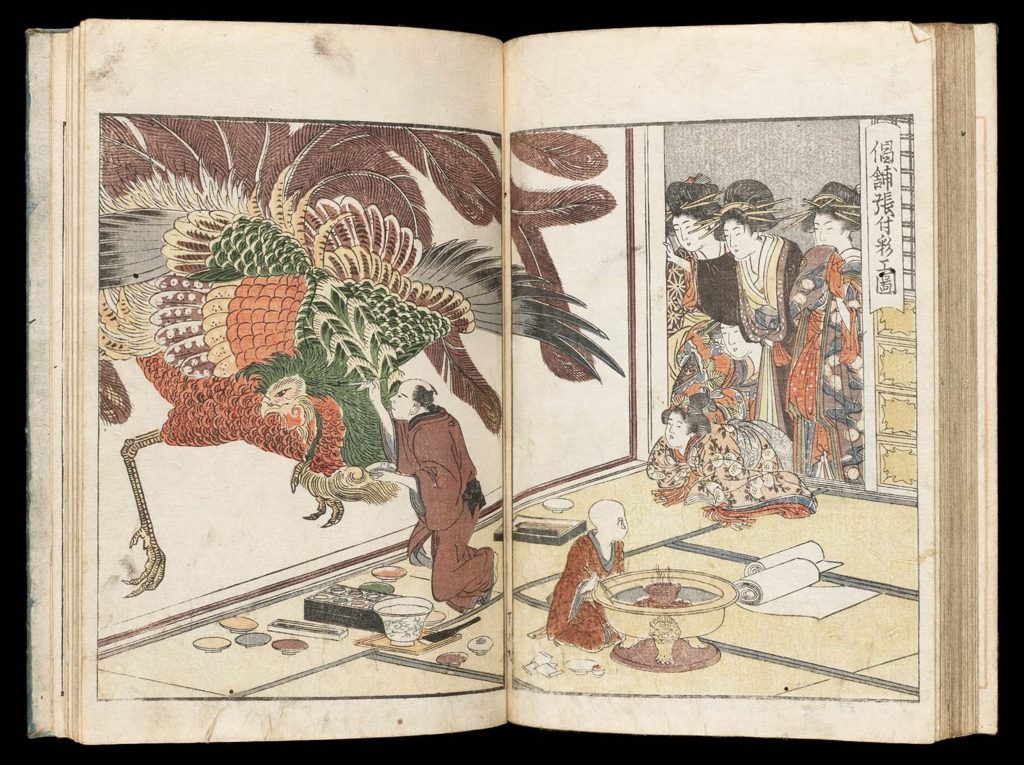
Utamaro has idealized himself painting this mural for the Niwaka Festivities. The artist was reputed to be overweight and homely, a Hitchcock-like figure, who, like the famous film director, depicted beautiful women with more grace and style than any of his rivals. In the above image, Utamaro decorates an interior with a painting of a ‘ho-o’ bird, watched by curious courtesans. The bird is a fantastical amalgam of different parts and is sometimes referred to as King of Birds or Fenghuang. It’s meant to amuse, to delight, to astonish with its imaginative extravagance. (Reference: The British Museum)
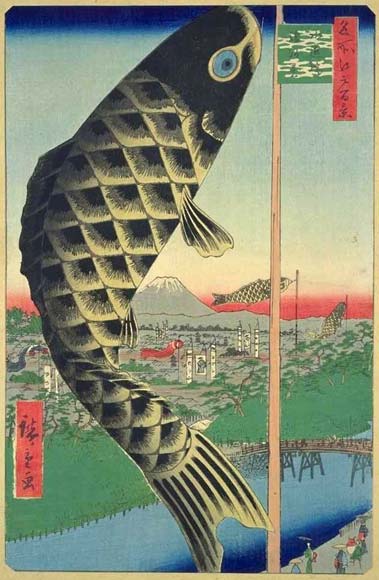
Carp-shaped wind socks mark a children’s holiday in Japan’s largest city. Hiroshige has created a startling effect by choosing a high angle, with the city landmarks receding in convincing perspective. The tail of the fish touches the river, giving the sense that it has leaped over the distant Fuji high into the sky.
The significance of the banners is explained in this note from the Brooklyn Museum: “Without the three immense carp banners, this view would have been a classic depiction of samurai Edo, looking southwest over the densest concentration of samurai households, from Surugadai on the left through Banchō in the distance. The banners and streamers indicate that the time is the Boy’s Festival, the fifth day of the Fifth Month. The three carp are standards used by commoners in imitation of the military streamers, which they were prohibited from flying. The banners drew on a Chinese legend of a fish so strong that it could leap a waterfall—an image considered an inspiring legend for young boys.”
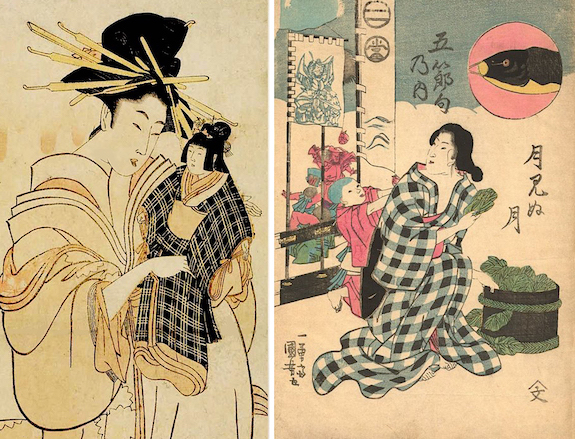
Often images that record festive themes, also showcase pretty young women, in this case, posing with doll and child. Take note of the elaborate coiffure of the woman on the left. To appreciate how much effort goes into such a look, the Art Institute of Chicago created a video called Recreating Ukiyo-e Hairstyles. In the picture with the boy, a fish-shaped flag, the same as in the Hiroshige, appears in a circle beside the vertical banners.

Does anything beat a celebrity’s arrival on the red carpet or catwalk, as advertisement for trend-setting fashion? Think Met Gala to get an idea of the impact of parading ôirans in 19th century Japan. The print, top left, depicts the courtesan Nagatô wearing a dazzling tiger costume. Art historian John Fiorillo comments: “Nagatô is on public display during a promenade in the Yoshiwara pleasure quarter. It is early spring, as she walks beneath a flowering cherry tree enclosed by a bamboo fence on Yoshiwara’s main street, the Naka-no-chô (“Middle Street”).”
“Many spectators would come not only to enjoy the blossoming trees,” Fiorillo comments, “but also to sit in the upper stories of teahouses to view the colorful spectacle of parading courtesans … Nagatô’s robes and accessories are of the most elaborate and expensive type for the period. Six tortoise-shell hairpins jut out on either side of her coiffure, and a large obi is tied in front. Most spectacular, of course, is the pattern of a fierce tiger standing on rocks amidst a waterfall. Such kimono were prohibitively expensive, affordable by only the highest ranking courtesans (gifts from wealthy patrons).”
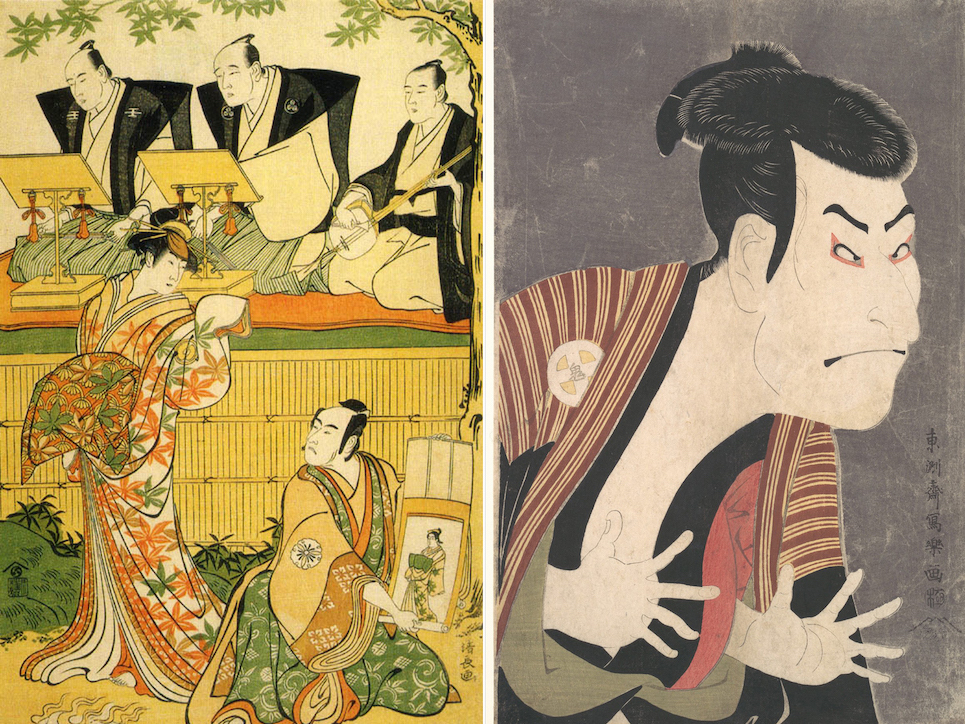
The Kabuki theatres in the pleasure district offered entertainments that ran all day. Actor prints were one of the first genres of ukiyo-e: records of stirring performances, mementos for fans and ads for shows. The prints often depict actors in frozen poses, struck at dramatic moments in as showy a manner as possible. The brilliant and enigmatic Sharaku broke this pattern by concentrating on close-ups of actors’ heads.
Sharaku may have had the shortest art career on record, a scant ten months. Little is known of the artist or why his output of prints ended so abruptly. One theory is that his portraits were a little too scathing and gave offence to powerful people who shut him down. What makes Sharaku’s prints so brilliant is that he captures both a likeness of the actor in caricature, as well as defining the actor’s role. In the image top right, Sharaku depicts an actor playing a villainous servant, grasping, frowning, eyebrows furrowed in intense concentration. The conception is bold, dynamic and conveys character with graphic immediacy.
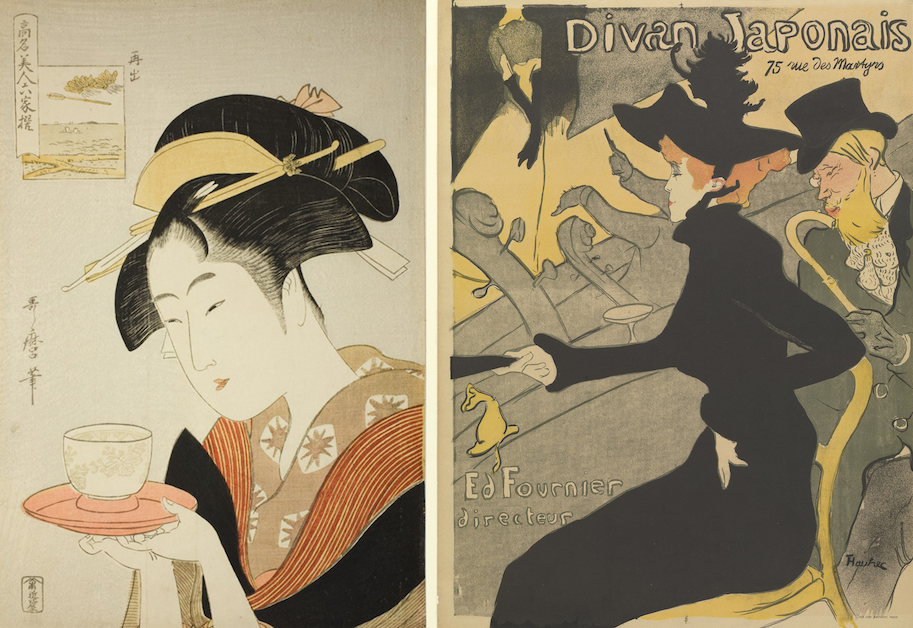
Japanese ukiyo-e inspired and is often compared with 19th century French art. When we look at the two traditions side by side, similarities leap off the page: flat colours, compressed spaces, contemporary subject matter, interest in a demi-monde situated in a pleasurable world of escapist fantasy. The prints record a thriving commercial pop culture. Both Utamaro and Lautrec display a racy wit: Utamaro compares a barmaid to a classical poet; Lautrec compares the curve of the bass instrument with the gentleman’s cane. The gentleman has the attitude of a predator more interested in the young lady than the musical performance. Both images are mass produced prints appealing to a middle class audience.
In these images, we see a seductive side to modernity, with the ascendancy of popular culture centred on celebrities and entertainment, the rapid dissemination of news and gossip, the intermixing of classes, the explosion of print material, innovative fashion and art that breaks with tradition in order to reflect the spontaneity of contemporary life with all its amusements and sexual attractions.